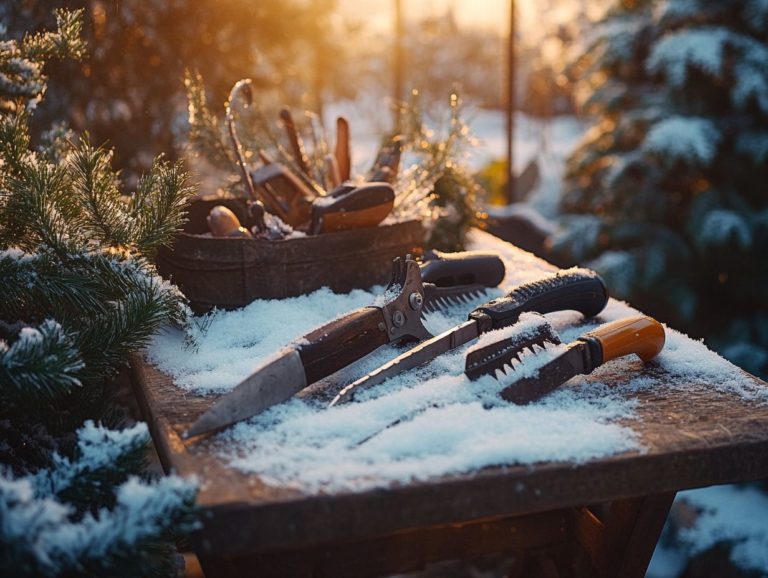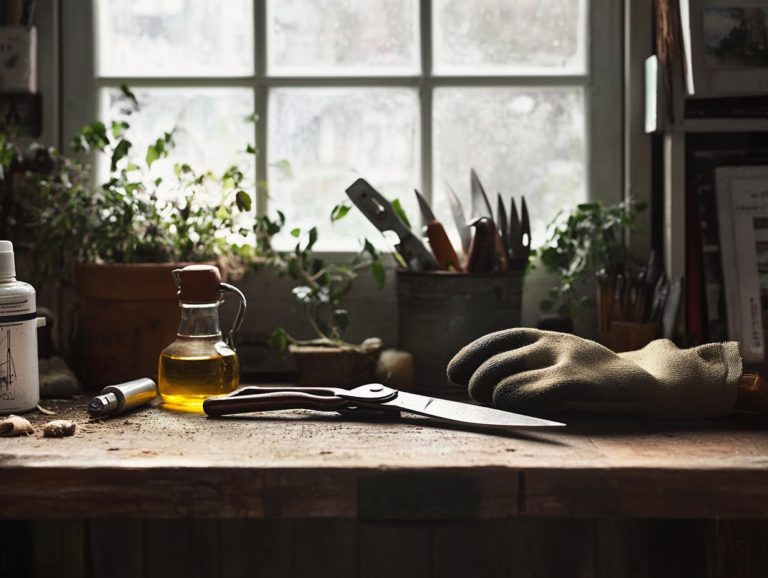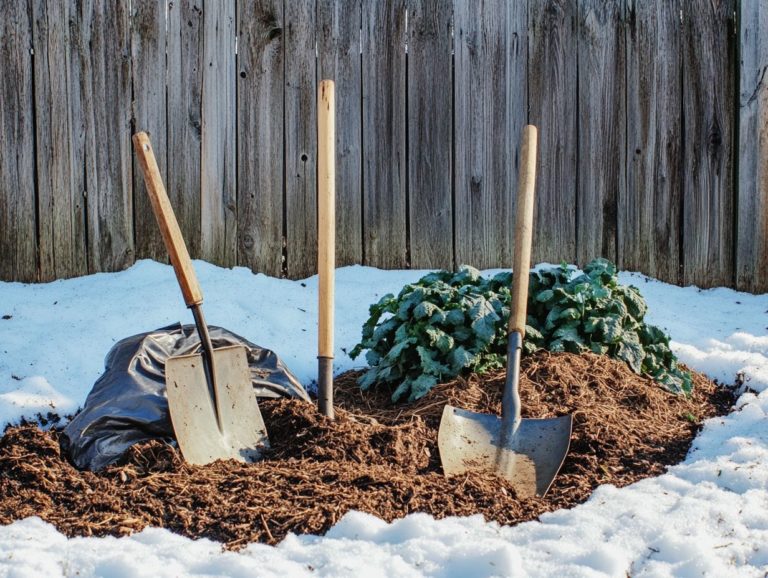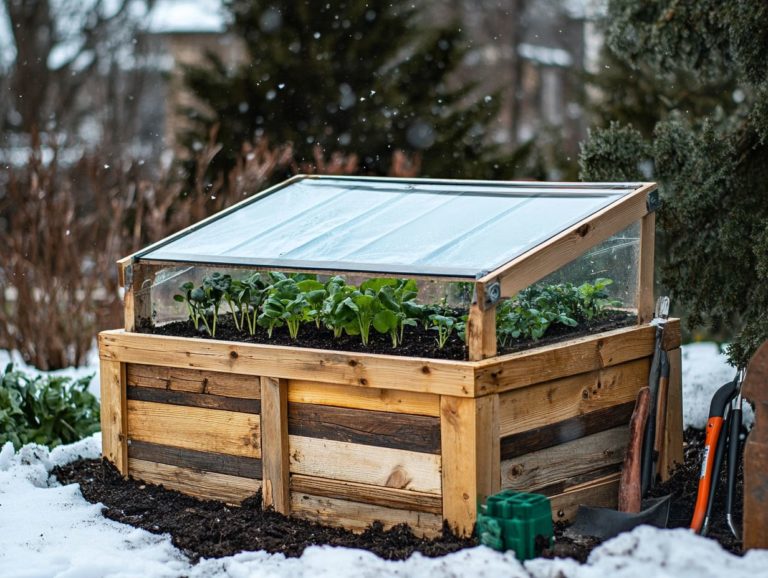How to Build a Simple Cold Frame
Looking to extend your gardening season and give your plants an early advantage? A cold frame might be exactly what you need.
This versatile structure not only protects your plants but also captures the sun s warmth, enabling you to grow everything from delicate seedlings to robust vegetables.
Dive into the world of cold frames and uncover what they are, the materials you’ll need, and a step-by-step guide to building one. You’ll also find tips on selecting the ideal location, the best plants to cultivate, and some innovative alternatives to traditional designs.
Are you excited to boost your gardening skills? Let s begin your gardening journey!
Contents
- Key Takeaways from Building a Cold Frame:
- What is a Cold Frame?
- Materials and Tools Needed
- Building the Frame
- Choosing the Right Location
- Planting and Maintaining a Cold Frame
- Best Plants to Grow and Care Tips
- Extending the Growing Season with a Cold Frame
- Benefits and Techniques
- Alternative Cold Frame Options
- DIY Ideas and Ready-Made Options
- Frequently Asked Questions
- What materials do I need to build a simple cold frame?
- Do I need any special tools to build a cold frame?
- How do I choose the best location for my cold frame?
- What is the purpose of a cold frame and how does it work?
- Can I use my cold frame all year round?
- Can I build a cold frame if I am not handy with tools?
Key Takeaways from Building a Cold Frame:
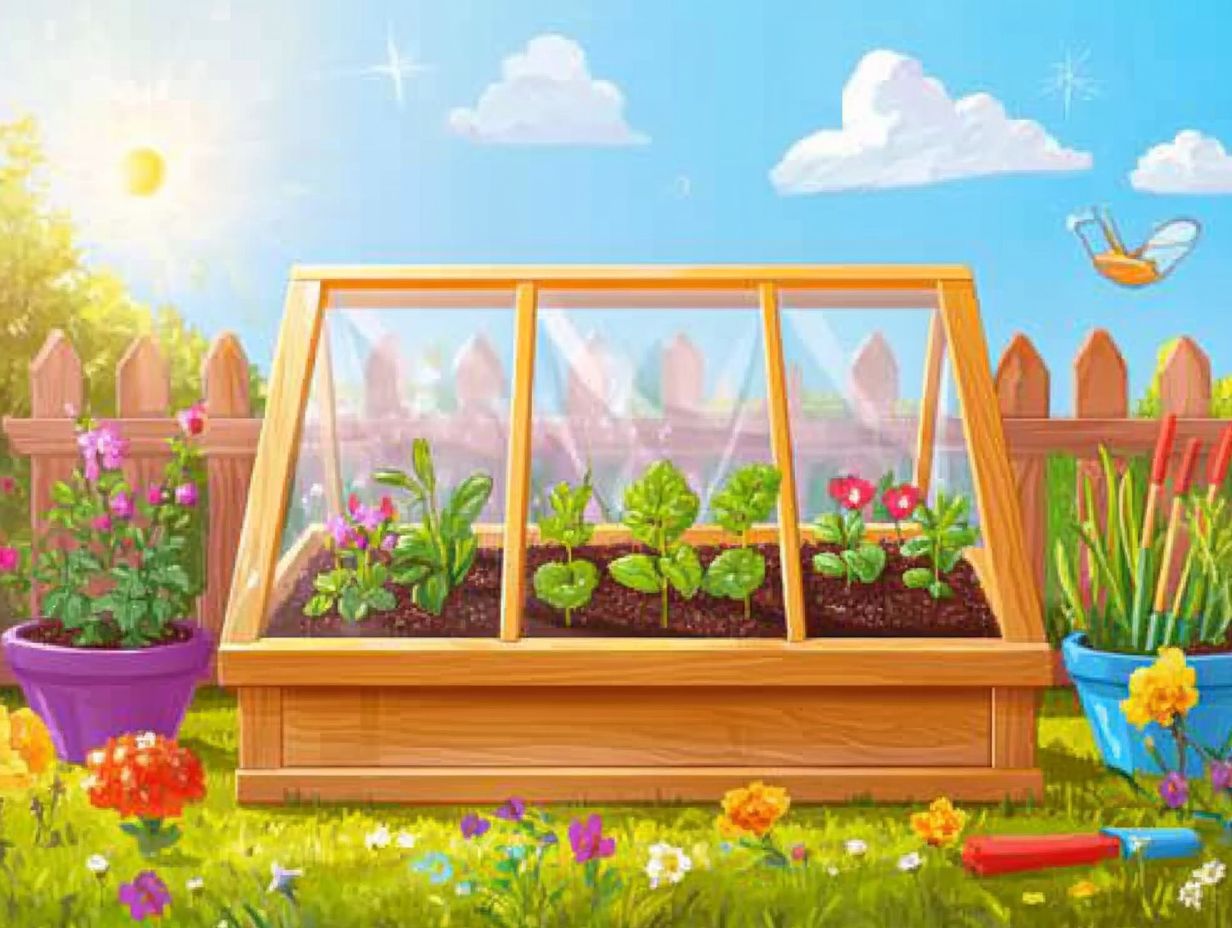
- Discover the definition and purpose of a cold frame as a useful gardening tool.
- Gather essential supplies and optional tools to build a DIY cold frame with step-by-step instructions.
- Learn how to choose the right location, best plants to grow, and care tips to extend the growing season with a cold frame.
What is a Cold Frame?
A cold frame is an elegant solution crafted to shield your plants from bad weather. It captures solar energy to generate a warm micro-environment conducive to growth.
This effective alternative to a greenhouse helps you grow tender perennials and cold-tolerant plants even in winter, effectively extending your growing season.
Constructed from materials such as plywood, pressure-treated lumber, acrylic top, and clear plastic, DIY cold frames can significantly elevate the productivity of your winter garden by harnessing thermal energy to sustain an optimal temperature for growing crops and nurturing plant seedlings.
Definition and Purpose
The primary purpose of a cold frame is to protect your plants from frost and bad weather while creating a nurturing environment for growth, much like a greenhouse effect.
By using clear panels, cold frames effectively trap solar energy, warming the air and soil inside and creating an ideal microclimate a small area with a different climate than surrounding areas for your young plants. This insulation helps you grow delicate plants that wouldn t survive outside.
You can also make the most of this setup to extend your growing season, often enabling the early sowing of seeds like lettuce and spinach or even providing a cozy home for tender herbs throughout the chilly months.
In this way, the cold frame becomes an invaluable asset in your winter garden toolkit, maintaining soil warmth and moisture while shielding your plants from biting winds and sudden temperature drops.
Materials and Tools Needed
To create a truly effective DIY cold frame, you ll need a well-thought-out materials list that includes essential tools and insulating materials.
Start with pressure-treated lumber for its exceptional durability, then consider using recycled windows or an acrylic top to maximize sunlight absorption. Don’t forget to add sealing oil for weatherproofing, ensuring your DIY cold frame stands the test of time.
Essential Supplies and Optional Tools
Essential supplies for building your cold frame include hinges, screws, and wood sealing products. All of these play a crucial role in ensuring the structure’s functionality and longevity.
To make your cold frame not only robust but also capable of withstanding the elements, consider adding materials like weather-resistant plywood and clear polycarbonate sheets. These components will help create a secure environment for your plants, trapping heat while allowing sunlight to stream in.
Optional tools like garden fabric and shading materials help manage heat levels and protect delicate plants from harsh sunlight.
Regarding maintenance, check for leaks or cracks regularly. Periodically resealing wood surfaces can significantly extend the life of your cold frame.
Add compost inside the cold frame. The heat generated by decomposing organic matter provides an extra warmth source, enhancing optimal growing conditions and fostering resilient plant growth.
Building the Frame
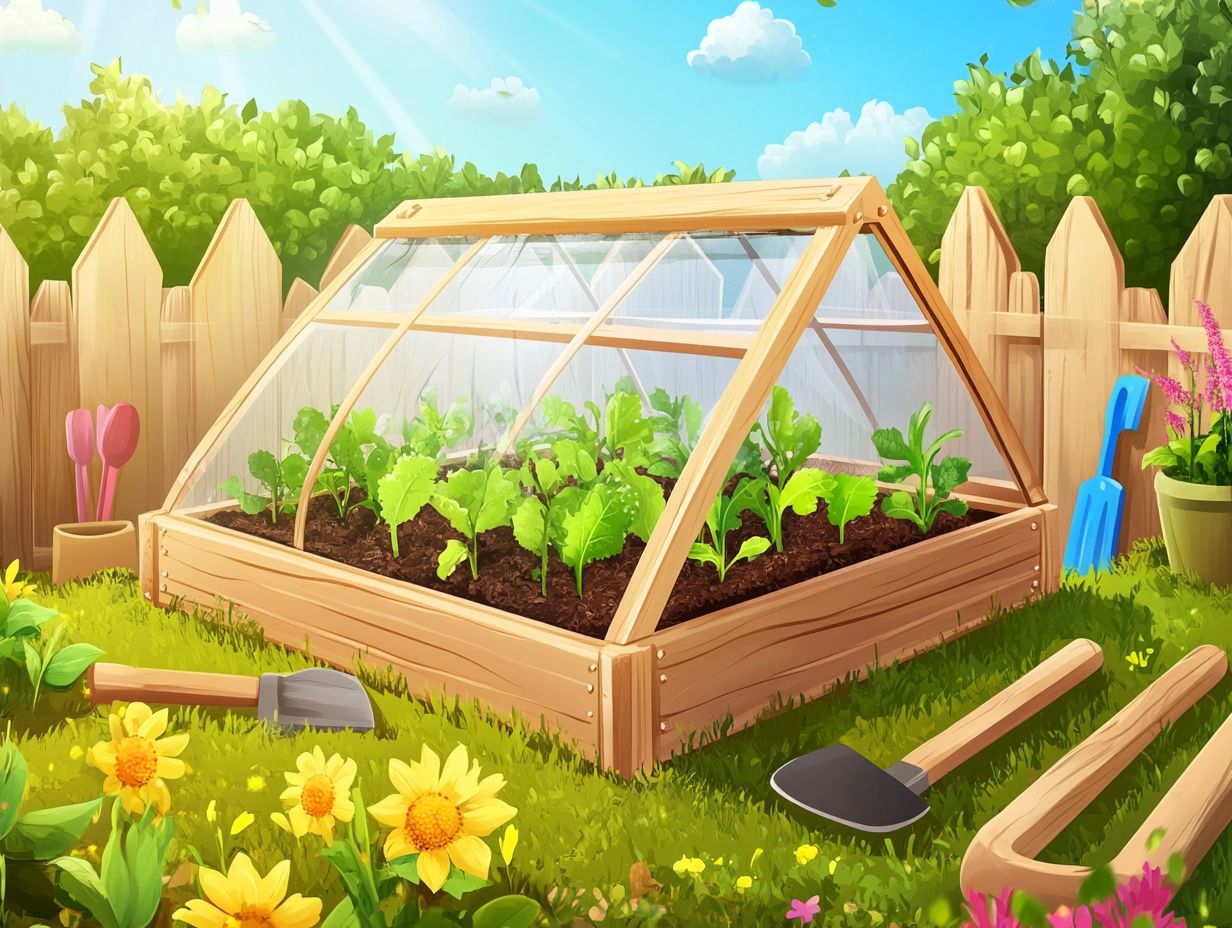
Constructing a cold frame requires you to adhere to detailed assembly instructions specific to your selected design. For best results, learn how to use cold frames effectively. The emphasis should be on crafting a robust yet easily accessible frame, complete with a precisely fitted lid that ensures proper ventilation.
Step-by-Step Instructions
Building a cold frame requires a methodical approach, starting with measuring and cutting your materials, assembling the frame, and finally installing the lid. For detailed instructions, check out how to create a cold-frame for gardening. Don’t forget to incorporate maintenance tips to ensure its longevity.
Before you embark on this construction journey, it’s crucial to choose the perfect location that maximizes sunlight exposure. Gather your tools and materials think wood, hinges, and a suitable lid material that allows light to flood in.
As you piece the structure together, ensure that the frame is sturdy and well-sealed. This will help protect your plants from harsh weather conditions.
Once it s all assembled, regularly check for any wear and tear. Clean the glass or plastic lid now and then to keep your cold frame in top-notch condition.
Get creative! Add shelves to hold plants of different heights or incorporate ventilation options for temperature control. This makes your cold frame a truly versatile asset in your gardening arsenal.
Choosing the Right Location
Selecting the ideal location for your cold frame is paramount. Considerations such as sunlight absorption, protection from biting winds, and convenient access play a pivotal role in enhancing its effectiveness and ensuring the vitality of your plants.
Factors to Consider
When choosing a location for your cold frame, consider key factors like sunlight availability, potential shading from nearby structures, and effective ventilation to ensure your winter garden thrives.
Start by assessing sunlight availability; ideally, your cold frame should bask in at least six hours of direct sunlight each day to foster optimal plant growth during the colder months. Visually inspect the area throughout the day to spot any shading effects from trees, fences, or buildings that could hinder light access.
Understanding how your cold frame traps heat is equally important. Positioning it on a south-facing slope can significantly enhance temperature management.
Don’t overlook ventilation; incorporating adjustable lids or hinges will allow for essential airflow, preventing overheating on sunny winter days while creating a nurturing environment for your plants.
Planting and Maintaining a Cold Frame
Successful planting and maintenance of a cold frame begins with selecting the finest cold-weather vegetables and plants to cultivate, particularly cold-tolerant plants that thrive in such environments.
By implementing effective maintenance strategies, you can ensure optimal performance and sustainability, allowing your cold frame to flourish beautifully throughout the seasons.
Best Plants to Grow and Care Tips
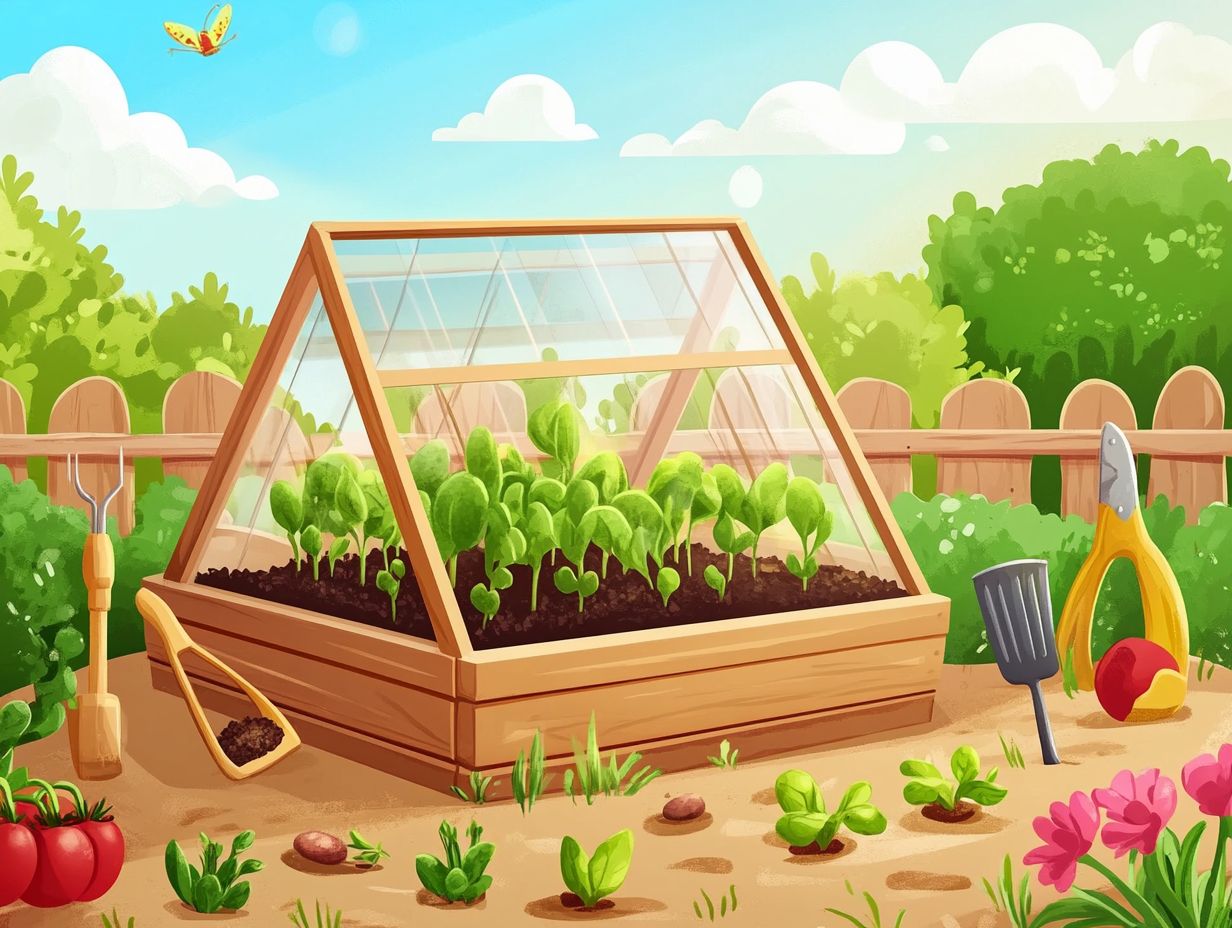
Some of the best plants for your cold frame include vegetables that can handle cold weather like radishes, spinach, and arugula. Alongside these, you ll find valuable tips for effective care and frost protection that can significantly enhance your yield.
You might also consider incorporating hardy herbs such as parsley and cilantro, which thrive in these structures, offering fresh flavors even when temperatures dip.
Managing humidity and ventilation is essential to prevent mold while ensuring your seedlings receive adequate air circulation. On frosty nights, using row covers lightweight fabric that helps keep plants warm or thermal blankets insulating covers that help keep plants warm can protect your plants from extreme cold.
Regular watering and attentive observation will set you up for optimal growing conditions, promoting healthy development and robust growth in any DIY cold frame setup.
Extending the Growing Season with a Cold Frame
Don t miss out on the opportunity to extend your growing season with a cold frame! This clever approach enables you to implement effective gardening techniques that not only capture warm air but also harness the heat generated by compost, fostering optimal plant growth.
Benefits and Techniques
Extending your growing season with a cold frame offers numerous advantages, including enhanced temperature control, increased yields, and a broader array of crops throughout the year.
This innovative agricultural technique gives you the power to nurture delicate seedlings, providing a safe haven during unpredictable weather conditions so they can flourish in a controlled environment. You can also make timely adjustments, like opening vents to release excess heat that may stress your plants. Managing humidity carefully is equally essential; employing moisture retention strategies, such as draping a damp cloth over the frame, can help create the perfect conditions for growth.
With a cold frame at your disposal, you can embrace seasonal planting. Jump into spring planting early for a fantastic harvest! You can start crops like lettuce and spinach earlier in the spring and savor a bountiful harvest well into late autumn truly maximizing your growing potential.
Alternative Cold Frame Options
Alternative cold frame options are abundant, offering a variety that suits your preferences from DIY projects crafted from scrap wood and recycled windows to elegant, ready-made structures readily available in the market.
Each of these options is thoughtfully designed to provide effective plant protection while ensuring a straightforward construction process.
DIY Ideas and Ready-Made Options
DIY projects for cold frames can be both cost-effective and tailored to your unique needs. Ready-made options provide the convenience and reliability you might seek for immediate solutions.
For many gardeners like you, especially those keen on extending the growing season without overspending, crafting your own cold frame can be a truly rewarding endeavor. With choices ranging from repurposed windows to wooden pallets, the creative possibilities are virtually limitless. By taking the DIY route, you can customize the structure to perfectly suit your specific requirements, ensuring it’s just the right size for your available space and particular plants.
On the flip side, commercially-prepared cold frames, while often constructed from durable materials, tend to come with a heftier price tag and limited design flexibility. This comparison underscores the advantages of personalization against the ease and quick setup of store-bought options, catering to gardeners of all skill levels.
Frequently Asked Questions
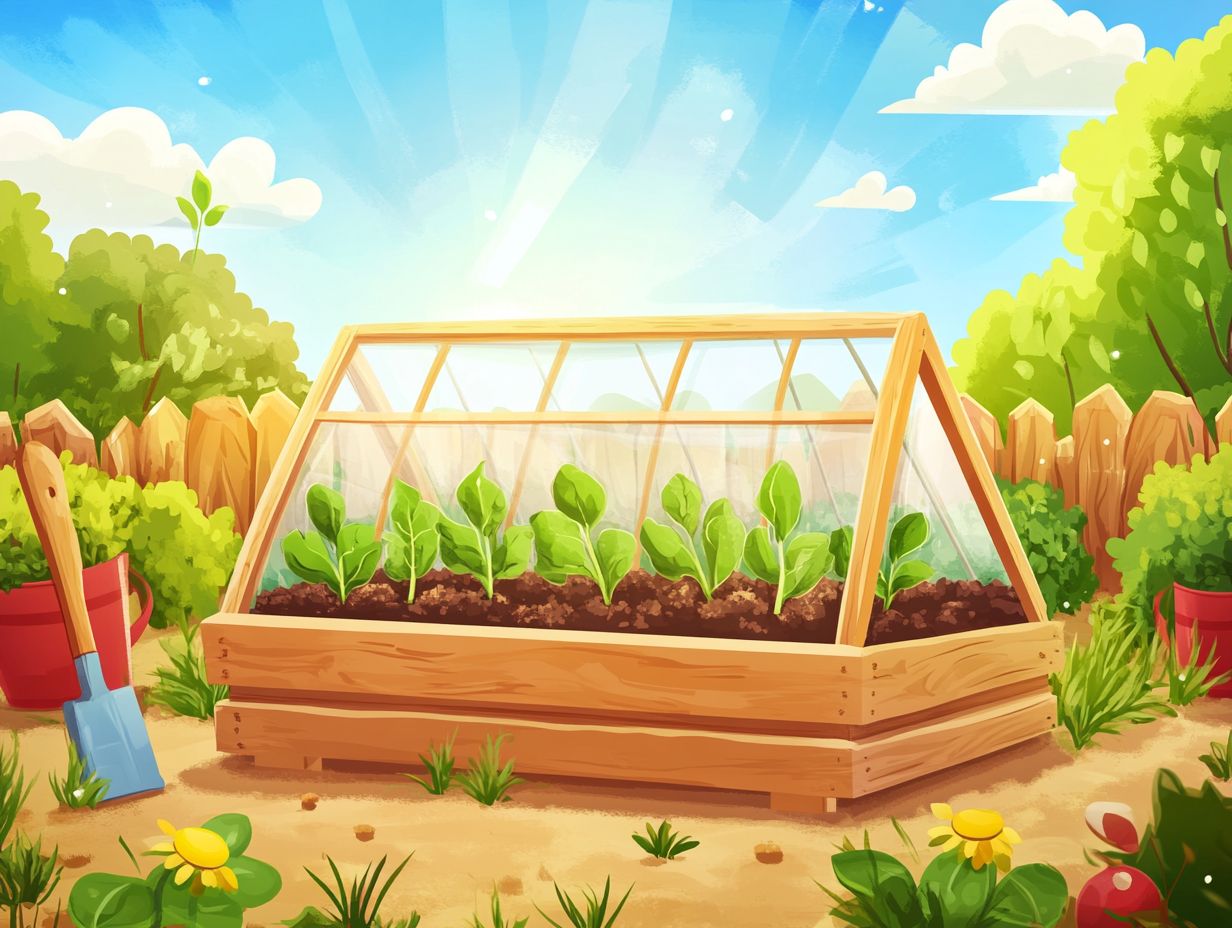
What materials do I need to build a simple cold frame?
To build a simple cold frame, you will need wooden boards, clear plastic sheeting, hinges, screws, a drill, and a hammer. For detailed instructions, check out this guide on how to use cold frames for winter gardening.
Do I need any special tools to build a cold frame?
No, you do not need any special tools. A drill and hammer will suffice.
How do I choose the best location for my cold frame?
Choose a location that receives plenty of sunlight and is sheltered from strong winds. Also, make sure the ground is level and well-drained.
Start building your cold frame today and enjoy the benefits of extended growing seasons!
What is the purpose of a cold frame and how does it work?
A cold frame helps extend the growing season for plants. It traps the sun’s heat, creating a warm environment for your plants to thrive.
Can I use my cold frame all year round?
Absolutely! Your cold frame can be your gardening ally all year long. Just adjust the ventilation and insulation as the seasons change.
Can I build a cold frame if I am not handy with tools?
Yes, building a simple cold frame is easy, even for beginners. Follow online tutorials or ask a handy friend or family member for help!

